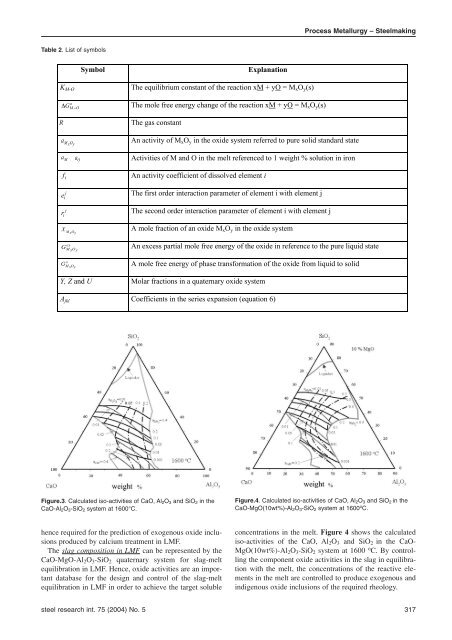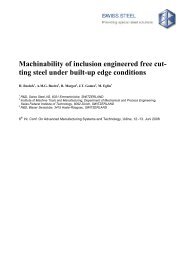Application of Thermodynamic Model for Inclusion Control in ...
Application of Thermodynamic Model for Inclusion Control in ...
Application of Thermodynamic Model for Inclusion Control in ...
Create successful ePaper yourself
Turn your PDF publications into a flip-book with our unique Google optimized e-Paper software.
Table 2. List <strong>of</strong> symbols<br />
KM-O<br />
o<br />
GM −O<br />
Symbol Explanation<br />
Figure.3. Calculated iso-activities <strong>of</strong> CaO, Al2O3 and SiO2 <strong>in</strong> the<br />
CaO-Al2O3-SiO2 system at 1600°C.<br />
The equilibrium constant <strong>of</strong> the reaction xM + yO = MxOy(s)<br />
∆ The mole free energy change <strong>of</strong> the reaction xM + yO = MxOy(s)<br />
R<br />
The gas constant<br />
hence required <strong>for</strong> the prediction <strong>of</strong> exogenous oxide <strong>in</strong>clusions<br />
produced by calcium treatment <strong>in</strong> LMF.<br />
The slag composition <strong>in</strong> LMF can be represented by the<br />
CaO-MgO-Al2O3-SiO2 quaternary system <strong>for</strong> slag-melt<br />
equilibration <strong>in</strong> LMF. Hence, oxide activities are an important<br />
database <strong>for</strong> the design and control <strong>of</strong> the slag-melt<br />
equilibration <strong>in</strong> LMF <strong>in</strong> order to achieve the target soluble<br />
Process Metallurgy – Steelmak<strong>in</strong>g<br />
aM xO<br />
An activity <strong>of</strong> MxOy <strong>in</strong> the oxide system referred to pure solid standard state<br />
y<br />
a M aO Activities <strong>of</strong> M and O <strong>in</strong> the melt referenced to 1 weight % solution <strong>in</strong> iron<br />
fi An activity coefficient <strong>of</strong> dissolved element i<br />
j<br />
e The first order <strong>in</strong>teraction parameter <strong>of</strong> element i with element j<br />
i<br />
j<br />
r The second order <strong>in</strong>teraction parameter <strong>of</strong> element i with element j<br />
i<br />
X A mole fraction <strong>of</strong> an oxide MxOy <strong>in</strong> the oxide system<br />
M xOy<br />
ex<br />
M xOy<br />
G An excess partial mole free energy <strong>of</strong> the oxide <strong>in</strong> reference to the pure liquid state<br />
o<br />
M xOy<br />
G A mole free energy <strong>of</strong> phase trans<strong>for</strong>mation <strong>of</strong> the oxide from liquid to solid<br />
Y, Z and U Molar fractions <strong>in</strong> a quaternary oxide system<br />
Ajkl<br />
Coefficients <strong>in</strong> the series expansion (equation 6)<br />
Figure.4. Calculated iso-activities <strong>of</strong> CaO, Al2O3 and SiO2 <strong>in</strong> the<br />
CaO-MgO(10wt%)-Al2O3-SiO2 system at 1600 o C.<br />
concentrations <strong>in</strong> the melt. Figure 4 shows the calculated<br />
iso-activities <strong>of</strong> the CaO, Al2O3 and SiO2 <strong>in</strong> the CaO-<br />
MgO(10wt%)-Al2O3-SiO2 system at 1600 o C. By controll<strong>in</strong>g<br />
the component oxide activities <strong>in</strong> the slag <strong>in</strong> equilibration<br />
with the melt, the concentrations <strong>of</strong> the reactive elements<br />
<strong>in</strong> the melt are controlled to produce exogenous and<br />
<strong>in</strong>digenous oxide <strong>in</strong>clusions <strong>of</strong> the required rheology.<br />
steel research <strong>in</strong>t. 75 (2004) No. 5 317










